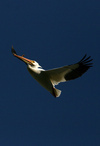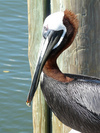Genus Pelecanus

Australian pelican - The Australian Pelican was first described by Dutch naturalist Coenraad Jacob Temminck in 1824. Its specific epithet is derived from the Latin verb conspicere 'to perceive', hence 'conspicuous'.
Dalmatian Pelican - This is the largest of the pelicans, averaging 170–190 cm in length, 11–15 kg in weight and just over 3 m in wingspan. On average, it's the world's heaviest flying species, although large male bustards and swans can exceed the pelican in maximum weight. It differs from the White Pelican in that it has curly nape feathers, grey legs and greyish-white plumage. It has a red lower mandible in the breeding season. Immatures are grey and lack the pink facial patch of immature White Pelicans. The latter also has darker flight feathers.
American White Pelican - The American White Pelican is a large aquatic bird from the order Pelecaniformes. It breeds in interior North America, moving south and to the coasts, as far as Central America, in winter.
Brown Pelican - It occurs on coasts in the Americas from Washington and Virginia south to northern Chile and the mouth of the Amazon River, as well as the island of Saut d'Eau in Trinidad and Tobago. Some immature birds may stray to inland freshwater lakes. After nesting, North American birds move in flocks further north along the coasts, returning to warmer waters for winter. Their young are hatched in broods of about 3, and eat around 150 lbs. of fish in the 8-10 month period they are cared for.
White Pelican - This is a large pelican, at a mass of 10 kg , 160 cm long and with a 280 cm wingspan. It differs from the Dalmatian Pelican, the only larger species of pelican, by its pure white, rather than greyish-white, plumage, a bare pink facial patch around the eye and pinkish legs. Males are larger than females, and have a long beak that grows in a downwards arc, as opposed to the shorter, straighter beak of the female. Immature birds are grey and have dark flight feathers. In flight, it is an elegant soaring bird, with the head held close to and aligned with the body by a downward bend in the neck. In breeding condition the male has pinkish skin on is face and the female has orangery skin.
Spot-billed Pelican - The Spot-billed Pelican is a relatively small pelican but still a large bird. It is 125–152 cm long and a weight of 4.1–6 kg . It is mainly white, with a grey crest, hindneck and a brownish tail. The feathers on the hind neck are curly and form a greyish nape crest. The pouch is pink to purplish and has pale large spots that are also present on the sides of the upper culmen. The tip of the bill is yellow to orange. In breeding plumage, the skin at the base of the beak is dark and the orbital patch is pink. In flight they look not unlike the Dalmatian Pelican but the tertials and inner secondaries are darker and a pale band runs along the greater coverts. The tail is rounder.
Pink-backed Pelican - The nest is a large heap of sticks, into which 2-3 large white eggs are laid. The chicks feed by plunging their heads deep into the adult’s pouch and taking the partially digested regurgitated fish.
Peruvian Pelican - The Peruvian Pelican, Pelecanus thagus, is a member of the pelican family. It lives on the west coast of South America, from Lobos de Tierra Island in Peru to Pupuya Islet in Chile.








